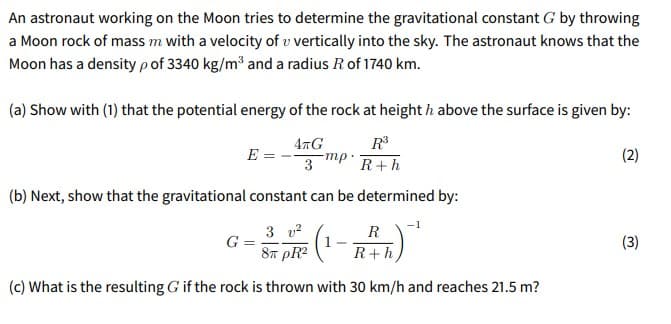An astronaut working on the Moon tries to determine the gravitational constant G by throwing a Moon rock of mass m with a velocity of v vertically into the sky. The astronaut knows that the Moon has a density pof 3340 kg/m and a radius Rof 1740 km. (a) Show with (1) that the potential energy of the rock at height h above the surface is given by: R 47G mp. 3 E (2) R+h (b) Next, show that the gravitational constant can be determined by: -1 3 v2 G 8n pR? R (3) R+h (c) What is the resulting G if the rock is thrown with 30 km/h and reaches 21.5 m?
An astronaut working on the Moon tries to determine the gravitational constant G by throwing a Moon rock of mass m with a velocity of v vertically into the sky. The astronaut knows that the Moon has a density pof 3340 kg/m and a radius Rof 1740 km. (a) Show with (1) that the potential energy of the rock at height h above the surface is given by: R 47G mp. 3 E (2) R+h (b) Next, show that the gravitational constant can be determined by: -1 3 v2 G 8n pR? R (3) R+h (c) What is the resulting G if the rock is thrown with 30 km/h and reaches 21.5 m?
Principles of Physics: A Calculus-Based Text
5th Edition
ISBN:9781133104261
Author:Raymond A. Serway, John W. Jewett
Publisher:Raymond A. Serway, John W. Jewett
Chapter6: Energy Of A System
Section: Chapter Questions
Problem 52P
Related questions
Question
Answer the question below showing detailly each step of your working.
Solution should be clear, simple and explicit enough!

Transcribed Image Text:An astronaut working on the Moon tries to determine the gravitational constant G by throwing
a Moon rock of mass m with a velocity of v vertically into the sky. The astronaut knows that the
Moon has a density pof 3340 kg/m³ and a radius R of 1740 km.
(a) Show with (1) that the potential energy of the rock at height h above the surface is given by:
R
47G
mp-
3
E
(2)
R+h
(b) Next, show that the gravitational constant can be determined by:
-1
3 v2
G
8n pR?
R
(3)
R+h
(c) What is the resulting G if the rock is thrown with 30 km/h and reaches 21.5 m?
Expert Solution
This question has been solved!
Explore an expertly crafted, step-by-step solution for a thorough understanding of key concepts.
Step by step
Solved in 4 steps with 4 images

Knowledge Booster
Learn more about
Need a deep-dive on the concept behind this application? Look no further. Learn more about this topic, physics and related others by exploring similar questions and additional content below.Recommended textbooks for you

Principles of Physics: A Calculus-Based Text
Physics
ISBN:
9781133104261
Author:
Raymond A. Serway, John W. Jewett
Publisher:
Cengage Learning

Glencoe Physics: Principles and Problems, Student…
Physics
ISBN:
9780078807213
Author:
Paul W. Zitzewitz
Publisher:
Glencoe/McGraw-Hill

Classical Dynamics of Particles and Systems
Physics
ISBN:
9780534408961
Author:
Stephen T. Thornton, Jerry B. Marion
Publisher:
Cengage Learning

Principles of Physics: A Calculus-Based Text
Physics
ISBN:
9781133104261
Author:
Raymond A. Serway, John W. Jewett
Publisher:
Cengage Learning

Glencoe Physics: Principles and Problems, Student…
Physics
ISBN:
9780078807213
Author:
Paul W. Zitzewitz
Publisher:
Glencoe/McGraw-Hill

Classical Dynamics of Particles and Systems
Physics
ISBN:
9780534408961
Author:
Stephen T. Thornton, Jerry B. Marion
Publisher:
Cengage Learning

University Physics Volume 1
Physics
ISBN:
9781938168277
Author:
William Moebs, Samuel J. Ling, Jeff Sanny
Publisher:
OpenStax - Rice University